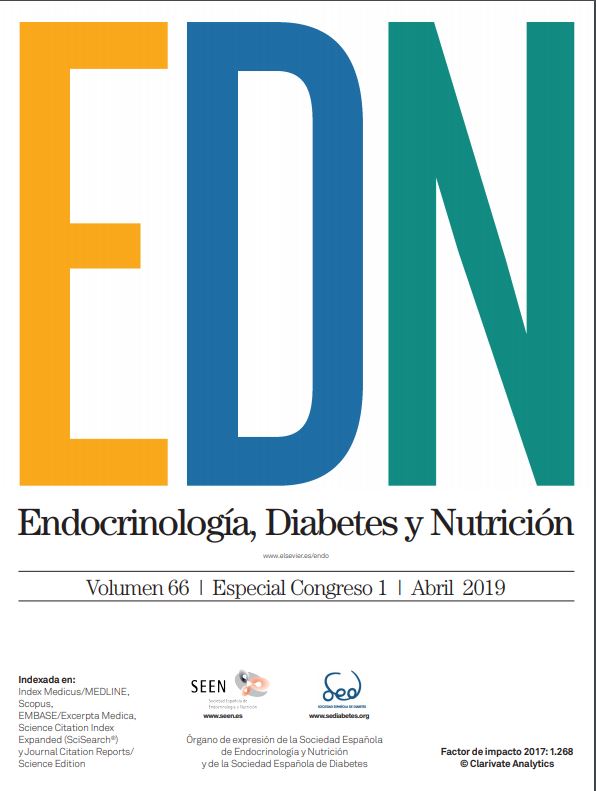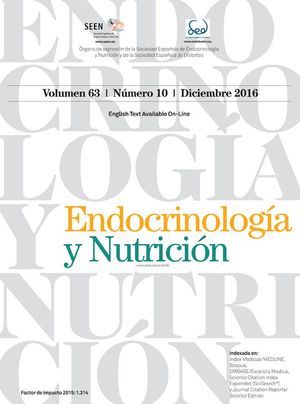P-184 - EFFECT OF NUTRITIONAL INTERVENTIONS ON PLASMA GLP-2 RESPONSE TO A MEAL TEST
aCentro de Investigación Biomédica en Red de Diabetes y Enfermedades Metabólicas Asociadas (CIBERDEM), Instituto de Salud Carlos III. Hospital Universitari de Tarragona Joan XXIII, Institut d'Investigació Sanitària Pere Virgili, Universitat Rovira i Virgili, Tarragona. bHospital Universitari de Tarragona Joan XXIII, Institut d'Investigació Sanitària Pere Virgili, Universitat Rovira i Virgili, Tarragona. cHospital Universitari de Tarragona Joan XXIII-Institut d´Investigació Sanitària Pere Virgili-Universitat Rovira i Virgili. CIBER de Diabetes y Enfermedades Metabólicas Asociadas (CIBERDEM)-Instituto de Salud Carlos III, Tarragona. dHospital Universitari de Tarragona Joan XXIII, Institut Investigació Sanitaria Pere Virgili, Universitat Rovira i Virgili. CIBER Diabetes y Enfermedades Metabólicas Asociadas (CIBERdem), Instituto de Salud Carlos III, Tarragona. eCentro de Investigación Biomédica en Red de Diabetes y Enfermedades Metabólicas Asociadas (CIBERDEM), Instituto de Salud Carlos III. Department of Endocrinology and Nutrition, Germans Trias i Pujol University Hospital-IGTP, Barcelona. fDepartment of Endocrinology and Nutrition, Bellvitge University Hospital-IDIBELL. Centro de Investigación Biomédica en Red de Diabetes y Enfermedades Metabólicas Asociadas (CIBERDEM), Instituto de Salud Carlos III, Barcelona.
Introduction: Glucagon-like peptide 2 (GLP-2) is released by intestinal L-cells in response to luminal nutrient stimulation. GLP-2 affects intestinal mucosa improving permeability, blood flow, and nutrient transport and decrease intestinal mobility. Recently, plasma GLP-2 has been associated with improvements in glucose metabolism by influencing insulin resistance (IR).
Objectives: We aimed to explore GLP-2 dynamics in response to a mixed meal test (MMT) in non-morbid obese (OB), morbid obese (MO) and type 2 diabetic patients (MOT2D), before and after weight-loss and its relationship with IR.
Methods: OB: dietary restriction with at least 10% weight-loss after 6 months (n = 18, BMI 35.4 ± 3.9 and 31.8 ± 3.7 kg/m2, respectively baseline and follow-up). MO: sleeve gastrectomy with 6 months follow-up (n = 18, BMI 45.0 ± 4.8 and 33.1 ± 4.4 kg/m2, respectively baseline and follow-up). MOT2D: Roux-en-Y gastric bypass with one-year follow-up (n = 13, BMI 39.3 ± 1.4 and 25.8 ± 2.1 kg/m2 respectively baseline and follow-up). MMT was performed before and after the follow-up period.
Results: At baseline, MOT2D showed higher fasting GLP-2 (FGLP-2) than nondiabetic groups (p = 0.005 and 0.002, respectively frente a OB and MO). Treatment decreased FGLP-2 in OB and MOB (p = 0.003 and 0.002 frente a baseline) and remained unchanged in MOT2D. The AUC GLP2 was higher in MOT2D than in the remaining groups both, before and after weight loss. The incremental AUC GLP-2 was clearly increased after treatment mainly in the surgically treated groups (p = 0.003 and 0.002 frente a baseline, respectively to MO and MOT2D). Considering the relationship with glucose metabolism variables, in the whole group, the FGLP-2 variability was associated with changes in Homa-IR (p = 0.045, rho = 0.297) and ISI index (p = 0.048, rho = -0.291). Changes in AUC GLP-2 were associated with changes in BMI (p = 0.002, rho = -0.453), AUCInsulin (p < 0.0001, rho = 0.627), AUCC-Peptide (p = 0.007, rho = 0.384) and, Insulinogenic index (p = 0.001, rho = 0.487).
Conclusions: Nutrients elicit a different GLP-2 response in presence of type 2 diabetes mellitus. In summary, we propose GLP-2 system as a new player in the physio-pathologic events that accounts in the metabolic glucose derangements such as occurs in T2D or morbid obesity.






